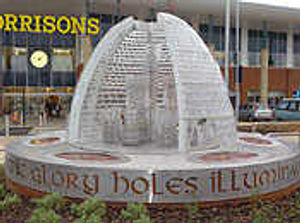Shoppers get a buzz out of artwork
Some call it a beehive, while to others it looks more like an igloo. But shoppers in Wednesbury agree on one thing – they're all in the dark about what the artwork which makes up the centrepiece of the new Morrisons supermarket actually is.

 Some call it a beehive, while to others it looks more like an igloo. But shoppers in Wednesbury agree on one thing – they're all in the dark about what the artwork which makes up the centrepiece of the new Morrisons supermarket actually is.
Some call it a beehive, while to others it looks more like an igloo. But shoppers in Wednesbury agree on one thing – they're all in the dark about what the artwork which makes up the centrepiece of the new Morrisons supermarket actually is.
At more than 10ft tall and built out of translucent glass bricks, Morrisons' homage to the town's pottery heritage of the 16th Century has yet to illuminate shoppers at the £20 million supermarket.
Christine Hay, who has regularly shopped at the store since its November 26 opening, said she liked the feature but admitted she had no idea what it was. "It looks like a beehive – I like it but I really don't know what it's supposed to be," she said.
Gilbert Sprole, aged 62, said he also thought the artwork had more than a touch of the beehive about it. Carer Sylvia Small said she thought the kiln was pretty but "a beehive" was also her best guess.
Michael Boxall, of Wednesbury, said he had no idea what the statue was.
"The supermarket's great though, and it's much more convenient for me than the one in Bilston that I used to go to," he said.
Sarah Hickman, 18, said she thought the kiln looked like an igloo.
Pensioner Charles Bott said he was unaware that the artwork was supposed to have anything to do with the town.
"It doesn't look like it's to do with the Black Country or industry," he said.
Pals Bradley Gillard, David Rogers and Peter Hill – all 15 – said they were fans of the monument – mainly because of its night-time lighting – but, again, none of them knew what it was.
An archaeological dig nearby uncovered a treasure trove of pottery dating back 500 years as well as 15 ancient kilns.
Experts said the findings showed important evidence of the town's pre-Industrial Revolution activities.
It is thought that one of the kilns, measuring three metres in diameter, was more than two metres tall. It was discovered surrounded by scorched earth, which had been reddened by intense heat.
Morrisons store manager Jim Brice insists that the artwork is self-explanatory on closer examination, although he wouldn't elaborate further.
"We try and make each of our stores as individual as possible so that they are unique to the area and a real asset to the local community," he said.





